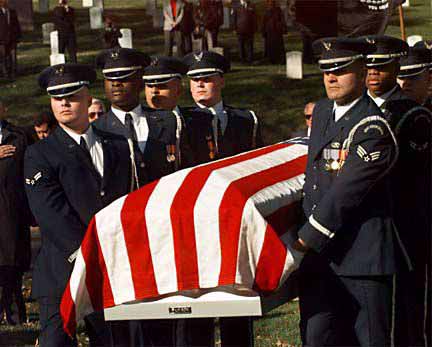 Originally known as Decoration Day, Memorial Day was a day set aside to honor the nation's Civil War casualties by decorating the soldier's graves.
Originally known as Decoration Day, Memorial Day was a day set aside to honor the nation's Civil War casualties by decorating the soldier's graves.
Memorial Day was first widely observed on May 30, 1868 to commemorates the sacrifices of the Civil War soldiers. General John A. Logan of the Grand Army of the Republic, an organization of former soldiers and sailors proclaimed the following:
"The 30th of May, 1868, is designated for the purpose of strewing with flowers, or otherwise decorating the graves of comrades who died in defense of their country during the late rebellion, and whose bodies now lie in almost every city, village, and hamlet churchyard in the land. In this observance no form of ceremony is prescribed, but posts and comrades will in their own way arrange such fitting services and testimonials of respect as circumstances may permit."
At first observance of Decoration Day, in 1868, General James Garfield (it would be another 14 years until he would be President) spoke at Arlington National Cemetery. Afterwards, some 5,000 attendees helped to decorate the graves of the more than 20,000 soldiers from both the Union and Confederate soldiers buried there.
Many Northern and Southern cities and towns claim to be the birthplace of Memorial Day. Some of these include Columbus, Miss.; Macon, Ga.; Richmond, Va.; Boalsburg.; and Carbondale, Ill. However it is Waterloo, New York who officially holds this honor.
In 1966, President Lyndon Johnson, declared Waterloo, N.Y., the official birthplace of Memorial Day. Waterloo was chosen because it had first celebrated a similar holiday on May 5, of 1866, and had made the day an annual community-wide event, where businesses would close and the townsfolk would decorate the graves with flowers and flags.
After World War I, the observances of the day began to honor those who had died in any and all of the American Wars. In 1971, Congress declared Memorial Day a national holiday which was to be celebrated or observed on the last Monday in May. Veteran's Day, a similar observance is celebrated on November 11 each year. I'm not exactly sure what the difference is.
 Today, like the original observance in 1868, Memorial Day is celebrated with a big to-do at Arlington National Cemetery. Small American flags are placed on each grave, and it is tradition that the president or vice-president to give a speech honoring the dead. A wreath is layed at the Tomb of the Unknown Soldier. About 5,000 people attend the ceremony annually.
Today, like the original observance in 1868, Memorial Day is celebrated with a big to-do at Arlington National Cemetery. Small American flags are placed on each grave, and it is tradition that the president or vice-president to give a speech honoring the dead. A wreath is layed at the Tomb of the Unknown Soldier. About 5,000 people attend the ceremony annually.
Additionally, many Southern states set aside another day honoring the dead of the Confederates. It's usually called Confederate Memorial Day. I'm not sure why this day would be any different from Memorial Day or Veteran's Day, but it must not be that important because I've lived in Georgia for two years and have never noticed April 26 as being Confederate Memorial Day.
Mississippi and Alabama celebrate the day on the last Monday in April. North and South Carolina it is May 10. Louisiana and Tennessee, June 3. Texas is January 19. And finally, Virginia takes the cake by celebrating Confederate Memorial Day on the same day as the Federal issued Memorial Day, on the last Monday in May.
That is it that the famous Virginian, Robert E. Lee said? Something about my state before my country. State before the country is the reason the Articles of Confederation failed... but that is for another time.
Even if you don't agree with our current conflict in Iraq, or if you were against our involvement in Vietnam. If you're still confused about our involvement in Korea, or agree with isolationism in World War I. Or have sour taste in your mouth about World War II. Even if you're a pacifist through hand through... today is a time to honor those that have died. Some are heroes, some are schleps. Many were suckered into going to war. Many were too scared to dodge the draft. Some want to be there. Some don't.
 All of them are to be honored.
All of them are to be honored.
Thank you to each and every person who's had a hand in protecting the freedoms of Americans, the Vietnamese, the Koreans, the Iraqis. Those that rid the world from Hitler and Mussolini. The ones who died protecting southern culture, or fighting for the equality of all men.
Thank you.







